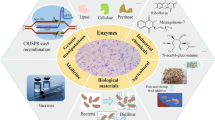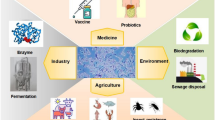Abstract
Bacillus licheniformis DnaK (BlDnaK) is predicted to consist of a 45-kDa N-terminal ATPase domain and a 25-kDa C-terminal substrate-binding domain. In this study, the full-length BlDnaK and its T86W and three C-terminally truncated mutants were constructed to evaluate the role of up to C-terminal 255 amino acids of the protein. The steady-state ATPase activity for BlDnaK, T86W, T86W/ΔC120, T86W/ΔC249, and T86W/ΔC255 was 65.68, 53.21, 116.04, 321.38, and 90.59 nmol Pi/min per mg, respectively. In vivo, BldnaK, T86W and T86W/ΔC120 genes allowed an E. colidnaK756-ts mutant to grow at 44°C. Except for T86W/ΔC255, simultaneous addition of B. licheniformis DnaJ and GrpE, and NR-peptide synergistically stimulated the ATPase activity of BlDnaK, T86W, T86W/ΔC120, and T86W/ΔC249 by 16.9-, 13.9-, 33.9-, 9.9-fold, respectively. Measurement of intrinsic tryptophan fluorescence revealed significant alterations of microenvironment of aromatic amino acids in the C-terminally truncated mutants. The temperature-dependent signal in the far-UV region for T86W was consistent with that of BlDnaK, but the C-terminally truncated mutant proteins showed a higher sensitivity toward temperature-induced denaturation. These results suggest that C-terminal truncations alter the ATPase activity and thermal stability of BlDnaK and induce the conformation change of the ATPase domain.






Similar content being viewed by others
References
Altschul SF, Gish W, Miller W, Myers EW, Lipman DJ (1990) Basic local alignment search tool. J Mol Biol 215:403–410
Banecki B, Zylicz M, Bertoli E, Tanfani F (1992) Structural and functional relationships in DnaK and DnaK756 heat-shock proteins from Escherichia coli. J Biol Chem 267:25051–25058
Borges JC, Ramos CHI (2006) Spectroscopic and thermodynamic measurements of nucleotide-induced changes in the human 70-kDa heat shock cognate protein. Arch Biochem Biophys 452:46–54
Boshoff A, Hennessy F, Blatch GL (2004) The in vivo and in vitro characterization of DnaK from Agrobacterium tumefaciens RUOR. Protein Expr Purif 38:161–169
Buchberger A, Theyssen H, Schröder H, McCarty JS, Virgallita G, Milkereit P, Reinstein J, Bukau B (1995) Nucleotide–induced conformational changes in the ATPase and substrate binding domains of the DnaK chaperone provide evidence for interdomain communication. J Biol Chem 270:16903–16910
Buchberger A, Gässler CS, Büttner M, McMacken R, Bukau B (1999) Functional defects of the DnaK756 mutant chaperone of Escherichia coli indicate distinct roles for amino- and carboxyl-terminal residues in substrate and co-chaperone interaction and interdomain communication. J Biol Chem 274:38017–38026
Buczynski G, Slepenkov SV, Schorn MG, Witt SN (2001) Characterization of a lidless form of the molecular chaperone DnaK: deletion of the lid increases peptide on- and off-rate constants. J Biol Chem 276:27231–27236
Bukau B, Horwich AL (1998) The Hsp70 and Hsp60 chaperone machines. Cell 92:351–366
Bukau B, Walker GC (1989) Delta dnak52 mutants of Escherichia coli have defects in chromosome segregation and plasmid maintenance at normal growth temperatures. J Bacteriol 171:6030–6038
Cellier MF, Teyssier J, Nicolas M, Liautard JP, Marti J, Sri Widada J (1992) Cloning and characterization of the Brucella ovis heat shock protein DnaK functionally expressed in Escherichia coli. J Bacteriol 174:8036–8042
Chesnokova LS, Slepenkov SV, Protasevich II, Sehorn MG, Brouillette CG, Witt SN (2003) Deletion of DnaK’s lid strengthens binding to the nucleotide exchange factor, GrpE: a kinetic and thermodynamic analysis. Biochemistry 42:9028–9040
Dagert M, Ehrlich SD (1979) Prolonged incubation in calcium chloride improves the competence of Escherichia coli cells. Gene 6:23–28
Farr CD, Slepenkov SV, Witt SN (1998) Visualization of a slow, ATP-induced structural transition in the bacterial molecular chaperone DnaK. J Biol Chem 273:9744–9748
Flynn GC, Chappell TG, Rothman JE (1989) Peptide binding and release by proteins implicated as catalysts of protein assembly. Science 245:385–390
Genevaux P, Georgopoulos C, Kelley WL (2007) The Hsp70 chaperone machines of Escherichia coli: a paradigm for the repartition of chaperone functions. Mol Microbiol 66:840–857
Gragerov A, Zeng L, Zhao X, Burkholder W, Gottesman ME (1994) Specificity of DnaK-peptide binding. J Mol Biol 235:848–854
Greene MK, Maskos K, Landry SJ (1998) Role of the J-domain in the cooperation of Hsp40 with Hsp70. Proc Natl Acad Sci USA 95:6108–6113
Grömping Y, Klostermeier D, Herrmann C, Veit T, Seidel R, Reinstein J (2001) Regulation of ATPase and chaperone cycle of DnaK from Thermus thermophilus by the nucleotide exchange factor GrpE. J Mol Biol 305:1173–1183
Grömping Y, Seidel R, Reinstein J (2005) Balance of ATPase stimulation and nucleotide exchange is not required for efficient refolding activity of the DnaK chaperone. FEBS Lett 579:5713–5717
Harrison CJ, Hayer-Hartl M, Di Liberto M, Hartl F, Kuriyan J (1997) Crystal structure of the nucleotide exchange factor GrpE bound to the ATPase domain of the molecular chaperone DnaK. Science 276:431–435
Hartl FU (1996) Molecular chaperones in cellular protein folding. Nature 381:571–579
Hesterkamp T, Bukau B (1998) Role of the DnaK and HscA homologs of Hsp70 chaperones in protein folding in E. coli. EMBO J 17:4818–4828
Johnson WC Jr (1990) Protein secondary structure and circular dichroism: a practical guide. Proteins 7:205–214
Lanzett PA, Alvarez LJ, Reinach PS, Candia OA (1979) An improved assay for nanomole amounts of inorganic phosphate. Anal Biochem 100:95–97
Marmur J (1961) A procedure for the isolation of deoxyribonucleic acid from microorganisms. J Mol Biol 3:208–218
Mayer MP, Bukau B (2005) Hsp70 chaperones: cellular functions and molecular mechanism. Cell Mol Life Sci 62:670–684
Michel GP (1993) Cloning and expression in escherichia coli of the dnaK gene of Zymononas mobilis. J Bacteriol 175:3228–3231
Minder AC, Narberhaus F, Babst M, Hennecke H, Fischer HM (1997) The dnaKJ operon belonging to the sigma32-dependent class of heat shock genes in Bradyrhizobium japonicum. Mol Gen Genet 254:195–206
Mogk A, Bukau B, Lutz R, Schumann W (1999) Construction and analysis of hybrid Escherichia coli–Bacillus subtilis dnaK genes. J Bacteriol 181:1971–1974
Montgomery DL, Morimoto RI, Gierasch LM (1999) Mutations in the substrate binding domain of the Escherichia coli 70 kDa molecular chaperone, DnaK, which alter substrate affinity or interdomain coupling. J Mol Biol 286:915–932
Moro F, Fernández-Sáiz V, Muga A (2003) Interdomain interaction through helices A and B of DnaK peptide binding domain. FEBS Lett 533:119–123
Moro F, Fernández-Sáiz V, Slutsky O, Azem A, Muga A (2005) Conformational properties of bacterial DnaK and yeast mitochondrial Hsp70: role of the divergent C-terminal α-helical subdomain. FEBS J 272:3184–3196
Paek KH, Walker GC (1987) Escherichia coli dnaK dull mutants are inviable at high temperatures. J Bacteriol 169:283–290
Palleros DR, Reid KL, McCarty JS, Walker GC, Fink AL (1992) DnaK, Hsp73, and their molten globules: two different ways heat shock proteins respond to heat. J Biol Chem 276:6098–6104
Pellecchia M, Montgomery DL, Stevens SY, Vander Kooi CW, Feng HP, Gierasch LM, Zuiderweg ER (2000) Structural insights into substrate binding by the molecular chaperone DnaK. Nat Struct Biol 7:298–303
Rey MW, Ramaiya P, Nelson BA, Brody-Karpin SD, Zaretsky EJ, Tang M et al (2004) Complete genome sequence of the industrial bacterium Bacillus licheniformis and comparison with closely related Bacillus species. Genome Biol 5:R77
Sambrook J, Russell DW (2001) Molecular cloning: a laboratory manual, 3rd edn. Cold Spring Harbor Laboratory, Cold Spring Harbor
Schlee S, Reinstein J (2002) The DnaK/ClpB chaperone system from Thermus thermophilus. Cell Mol Life Sci 59:1598–1606
Shi L, Kataoka M, Fink AL (1996) Conformational characterization of DnaK and its complexes by small-angle X-ray scattering. Biochemistry 35:3297–3308
Slepenkov SV, Witt SN (2003) Detection of a concerted conformational change in the ATPase domain of DnaK triggered by peptide binding. FEBS Lett 539:100–104
Suh WC, Burkholder WF, Lu CZ, Zhao X, Gottesman ME, Gross CA (1998) Interaction of the Hsp70 molecular chaperone, DnaK, with its cochaperone DnaJ. Proc Natl Acad Sci USA 95:15223–15228
Szabo A, Langer T, Schröder H, Flanagan J, Bukau B, Hartl FU (1994) The ATP hydrolysis-dependent reaction cycle of the Escherichia coli Hsp70 system DnaK, DnaJ, and GrpE. Proc Natl Acad Sci USA 91:10345–10349
Tilly K, Hauser R, Cambell J, Ostheimer EC (1993) Isolation of dnaJ, dnaK, and grpE homologues from Borrelia burgdorferi and complementation of Escherichia coli mutants. Mol Microbiol 7:359–369
Vogel M, Mayer MP, Bukau B (2006) Allosteric regulation of Hsp70-chaperones involves a conserved interdomain linker. J Biol Chem 281:38705–38711
Zhang H, Lin L, Zeng C, Shen P, Huang YP (2007) Cloning and characterization of a haloarchaeal heat shock protein 70 functionally expressed in Escherichia coli. FEMS Microbiol Lett 275:168–174
Zhu X, Zhao X, Burkholder WF, Gragerov A, Ogata CM, Gottesman ME, Hendrickson WA (1996) Structural analysis of substrate binding by the molecular chaperone DnaK. Science 272:1606–1614
Zuber M, Hoover TA, Dertbaugh MT, Court DL (1995) Analysis of the DnaK molecular chaperone system of Francisella tularensis. Gene 164:149–152
Acknowledgments
We thank Prof. Hsien-Bin Huang of Institute of Molecular Biology, National Chung Cheng University for his thoughtful discussions to improve this manuscript. This work was supported by the research grants (NSC 95-2313-B-415-012-MY3 and NSC 97-2628-B-415-001-MY3) from National Science Council of Taiwan.
Author information
Authors and Affiliations
Corresponding authors
Additional information
Communicated by Wolfgang Buckel.
Wan-Chi Liang and Min-Guan Lin contributed equally to this work.
Rights and permissions
About this article
Cite this article
Liang, WC., Lin, MG., Chi, MC. et al. Deletion analysis of the C-terminal region of a molecular chaperone DnaK from Bacillus licheniformis . Arch Microbiol 191, 583–593 (2009). https://doi.org/10.1007/s00203-009-0485-8
Received:
Revised:
Accepted:
Published:
Issue Date:
DOI: https://doi.org/10.1007/s00203-009-0485-8




